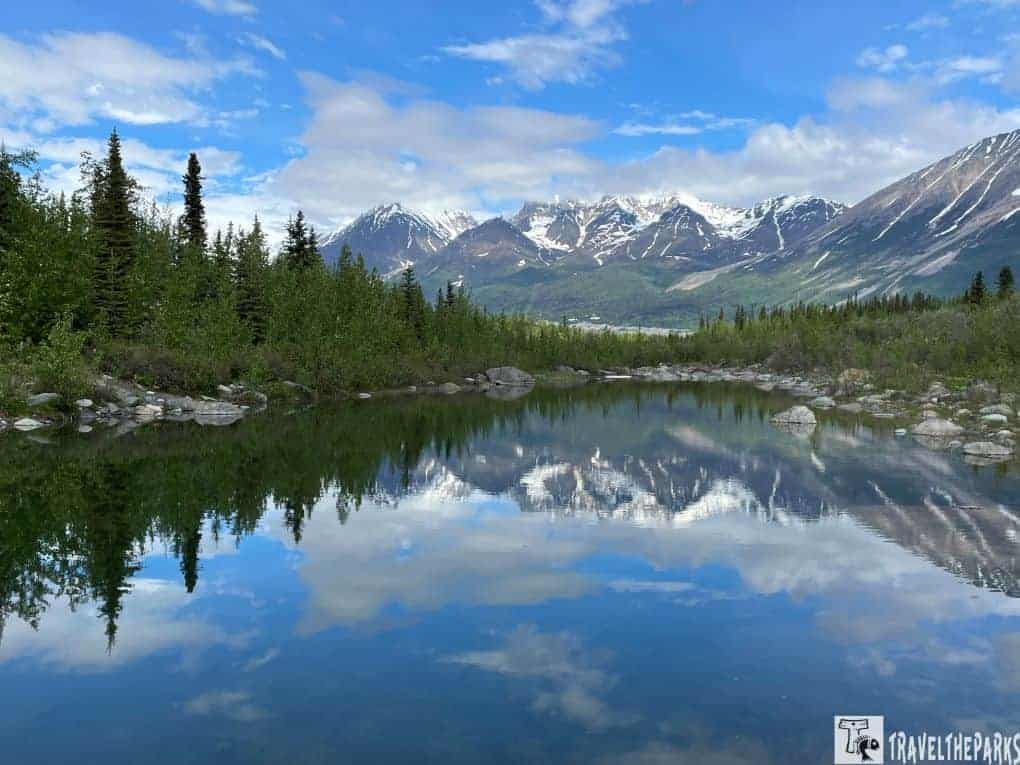Table of Contents
Post Updated April 23 2023
Unimaginable beauty, that is what you see visiting Mammoth Hot Springs in Yellowstone National Park. It is located 5 miles south of the Gardiner, North Entrance to Yellowstone. The area is easily accessible year-round by car. Coming from Norris Geyser Basin on the Grand Loop Road south, you descend through the switchbacks into the valley until the first thing you notice is the steaming otherworldly terraces. Our view included storm clouds hovering over Gallatin Mountain Range, making a beautiful backdrop to the valley. It’s primarily a Montanan range, though significant parts lie in Wyoming. More than half of the range lies in Gallatin National Forest, though its southern portions lie in the northwestern quarter of Yellowstone National Park.
This post may contain affiliate links, meaning if you purchase something through one of these links, we may earn a small commission at no extra cost to you! Read the full disclosure policy here.

Where to Stay When Visiting Mammoth Hot Springs in Yellowstone
There are several options for lodging in or near Mammoth Hot Springs. It’s important to book your accommodations well in advance, especially during the peak summer season when lodging can fill up quickly.
- Mammoth Hot Springs Hotel and Cabins: This historic hotel lies in the heart of the Mammoth Hot Springs area and offers a variety of accommodations, including hotel rooms and cabins
- The town of Gardner, Montana, is just outside the park’s North Entrance and offers a variety of lodging options, including hotels, cabins, and vacation rentals.
- There are several campgrounds in the Mammoth Hot Springs area, including the Mammoth Campground, which is walking distance of the hot springs.

Mammoth Hot Springs Hotel and Cabins in Yellowstone
They built the Mammoth Hot Springs Hotel in 1911 and recently renovated all the rooms in the hotel. I highly recommend staying in the park just for the proximity to everything. The hotel is within walking distance of the Mammoth Hot Springs Terraces and the Mammoth Hot Springs Historic District, making it a convenient base for exploring the area.

Although you give up TV, Internet access, and cell phone coverage for the privilege of early access to the park. I gladly give it up to be close to wildlife and enjoying other amenities within the park is worth the loss of technology access. The newly renovated hotel rooms are beautifully done, keeping the original authentic feel while maintaining a top-notch and updated style. The rooms can be a real value price-wise for those that want to stay within the park.
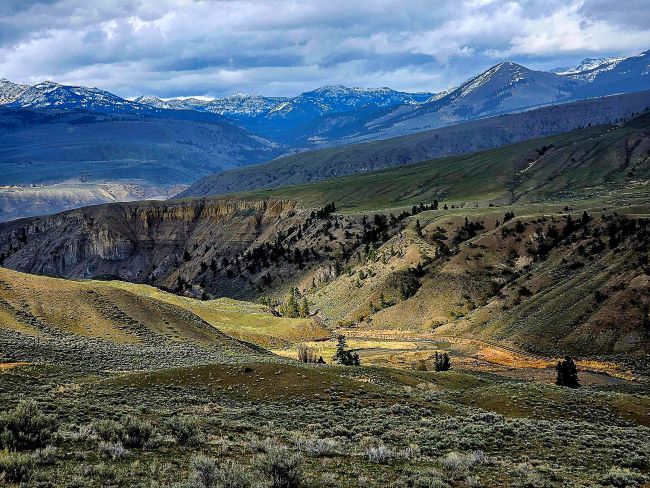
Overnight Adventure at Mammoth’s Historic Frontier Cabins
We stayed in a rustic frontier cabin that we reserved a year in advance. Check-in and out was fast and efficient. The cabins are simple but comfortable, with basic furnishings and amenities. Our cabin had two queen beds and a private bath. Some cabins have a shared bathroom. Although our cozy cabin was a duplex, we did not have any issues with noisy neighbors. The cabins are reasonably clean, roomy, and heated. It would be great if there was coffee in the room and access to a small refrigerator. However, they so provide complimentary coffee and tea in the hotel lobby.
The cabin also had a cute bear soap I kept as a souvenir. Some cabins had privately fenced hot tubs at an additional cost. I loved the focus on simplicity and immersion in nature at this location. There was plenty of wildlife on the lawn in the grassy common area. It was fascinating watching the ground squirrels scurrying under porches while avoiding large elk.
These cabins are older too, say the least, so don’t expect premium accommodations. That said, I loved the feel of the rustic cabins and would stay here again; they are a great value and I prefer the isolation the cabins provide. All the cabins are pet friendly. This property, like all the lodging in Yellowstone, is extremely environmentally conscious.

Exploring Mammoth Hot Springs Yellowstone: Walk the Grounds and Spot Wildlife
The small porch on the front of the cabin was an ideal place to sit, both in the evening and in the morning, to watch the elk or ground squirrels. Walking the cabin loop road, be cautious when around elk. Yellowstone National Park is home to a large population of elk, and visitors should be aware of the potential dangers associated with encountering these animals. During the fall mating season, also known as the “rut,” male elk can become aggressive and territorial, and may attack humans who get too close. Feeding elk (or any animal) can cause them to become aggressive and reliant on human food, which can be dangerous for both humans and the animals. Visitors should always maintain a safe distance and follow park guidelines for wildlife viewing. Take the Yellowstone pledge. Sadly, visitors disregard this advice and get hurt every year.
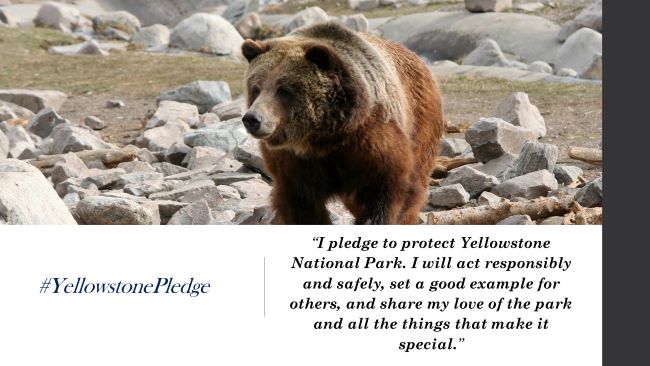
Dining in Mammoth Hot Springs
There are several dining options available in Mammoth Hot Springs, including:
- Mammoth Hot Springs Hotel Dining Room: This full-service restaurant is located inside the historic Mammoth Hot Springs Hotel and serves breakfast, lunch, and dinner. The menu features classic American dishes with a focus on locally sourced ingredients.
- Terrace Grill: This casual dining spot is located next to the Mammoth Hot Springs Terraces and offers a variety of fast-casual options, including burgers, sandwiches, and salads.
- Map Room Lounge: This cozy lounge is located inside the Mammoth Hot Springs Hotel and serves a variety of cocktails, beer, and wine. The lounge also features a fireplace and comfortable seating, making it a great spot to relax after a long day of exploring.
- General Store Deli: This casual spot is located inside the Mammoth Hot Springs General Store and offers a variety of grab-and-go options, including sandwiches, salads, and snacks.
- Bear Den Gift Shop: This gift shop features a small café area that serves coffee, tea, and pastries. It’s a great spot to grab a quick snack or drink while shopping for souvenirs.

Delight for the Senses in the Mammoth Dining Hall
We started the day with an early morning walk. The air was about 40 degrees and the wind was blowing from the north. We bundled up in layers. For a full-service dining experience, you can eat at the Mammoth Hotel Dining Room. We had a light breakfast in the Mammoth Hotel Dining Hall. The food is satisfying here. They don’t take reservations for the dining room, so seating is on a basis first-come, first-serve.
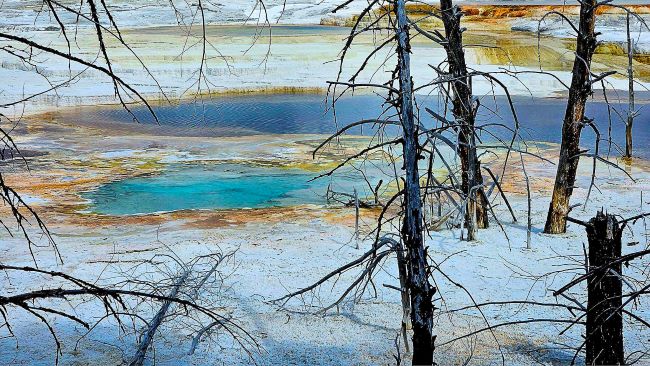
We arrived at the dining room when it opened at 7am and got seated immediately. There is a nice breakfast buffet, but we ordered from the menu. The short stack of pancakes was enormous enough for two people. The huckleberry syrup is excellent. I had eggs with the toast; the eggs were light, and fluffy, and delicious. The service was amazing and our server was very attentive, asking us about our adventures in the park to date. We noticed the couple across from us did not get served directly, so we asked our server and they were taken care of after that.

Grab a Quick Snack at the Terrace Grill
The Terrace Grill is a great option for something light and fast. It’s cafeteria-style, where you place your order, pay, and then they call your number when it’s ready. You pick it up at a counter and carry it to your table. Service was quick once we got to the counter to place our order. The evening we arrive the place was busy. I ordered a cheesesteak sandwich and a glass of Chardonnay wine, while Barry enjoyed a hot dog with a beer. The seating area has really large windows that look out at the mountains that surround the valley. The Terrace Grill also has a separate ice cream counter. I must say, their ice cream was excellent. I recommend trying the Huckleberry favor. The serving portions are very generous and can easily be shared between two people.

Best Things to do at Mammoth Hot Springs in Yellowstone NP
There are plenty of things to do and see in the Mammoth Hot Springs area of Yellowstone National Park. Here are some of the best:
- The major attraction in Mammoth Hot Springs is the terraces, which are made up of unique mineral formations that hot springs have created over thousands of years. Visitors can walk along the boardwalks to explore the different terraces and see the colorful and intricate formations up close.
- Fort Yellowstone Historic District includes several buildings that were once part of Fort Yellowstone, a military outpost established in the early 1900s to protect the park. Visitors can take a self-guided tour of the area to learn more about the history of the park and the role of the military in its development.
- There are several hiking trails in the Mammoth Hot Springs area, ranging from easy strolls to more challenging hikes. Some of the most popular trails include the Beaver Ponds Loop Trail, the Bunsen Peak Trail, and the Wraith Falls Trail.
- The Mammoth Hot Springs area is home to a variety of wildlife, including elk, bison, bears, and coyotes. Visitors can often see these animals from the safety of their cars or by taking guided wildlife tours.
- The park offers a variety of ranger-led programs, including guided hikes, campfire talks, and educational programs for kids. These programs are a great way to learn more about the park’s history, geology, and wildlife.

Everything You Need to Know About the Mammoth Terrace Walk
Mammoth Hot Springs is a short walk from the hotel and is best viewed earlier in the morning or later in the afternoon to beat the crowds and tour groups. Our morning strategy had become that we wake early to beat the crowds. The crowds that by midday make it hard to experience the sites of Yellowstone.
They divide the hot springs into Lower Terrace, which is all boardwalks (about 1.5-2 miles) and Upper Terrace, which is a one-way 1.5-mile road. There are 4 parking lots and 1 overflow parking for the Lower Terrace. At the Upper Terrace Drive, there is 1 big parking lot just before you enter the one-way road and 2 parking lots along the drive. There are also several pullouts along the drive to allow you to take photos. I recommend you get a booklet, “Mammoth Hot Springs Trail Guide” from the visitor center ($1 donation). It has information and description of the features in the Mammoth hot spring,

Self Guided Walking Tour through the Lower Terrace
It takes a little over an hour to hike the boardwalk trail (1.75 miles), climbing in elevation-300 ft. One notable feature of Mammoth Hot Springs is its ever-changing travertine terraces, the spectacular colors of the pools created by the extremophile bacteria that live in the thermal pools. The water evaporates it deposits limestone giving birth to travertine, created over thousands of years as boiling water from the spring cooled and deposited calcium carbonate.
I kept thinking how otherworldly this must have seemed to the early explorers. The steam rises in clouds from many vents; eerily stunted trees encased in calcium within the encrusted cascades of the terraces. The soft creamy tones of the travertine background with the smoky darkened skies made the entire place appear surreal.
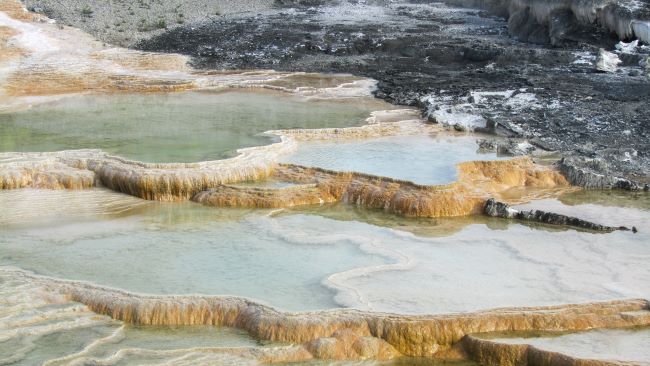
Fascinated Springs in the Lower Terrace
Starting at the trailhead near the Lower Terrace’s parking lot, we followed the boardwalk as we cross a footbridge down a few stairs before reaching the Canary Spring. Mesmerized, we lingered for a bit.
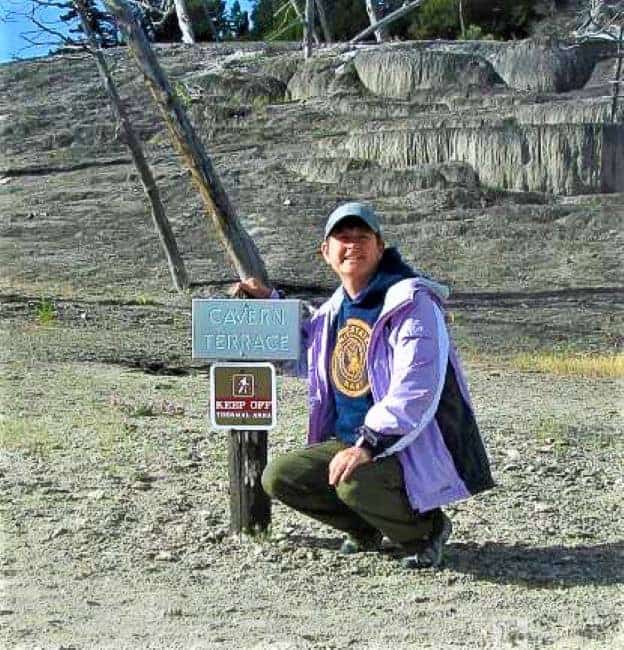
This vantage point at the end of the boardwalk overlooking Canary Springs is a great place for trying to capture the colors and contours of the spring; NO matter how many pictures can you take in, you still won’t capture the essence of Yellowstone because you must see it, hear it, smell it, live it to truly experience it.
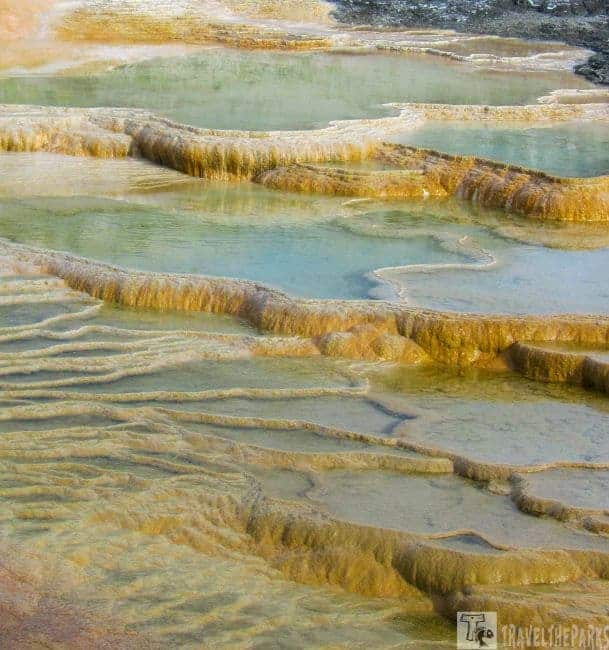
From Canary Spring, we continued along the boardwalk, noticing the New Blue Spring so named for its striking blue color, which is created by the reflection of blue light off of the silica-rich water. Cupid Spring is known for its intricate and delicate formations, which resemble miniature terraces, and its unique pink and white coloration. Next we reached Cleopatra Terrace, named for its resemblance to a cascading waterfall. To me I though the smooth surface that resembles the skin of a reptile.

One of the most prominent features of the lower terraces is the “Minerva Terrace,” named after the Roman goddess of wisdom. The notable features vibrant orange, pink, and white colors created by thermophilic (heat-loving) bacteria and algae that live in the hot water.
Representative of the Roman god Jupiter terrace is so named for its grandeur and size. Its stunning white and beige colors, which are created by the deposition of calcium carbonate by the hot springs.
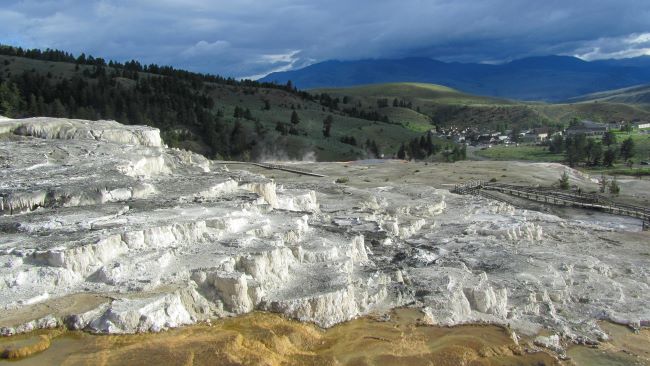
Exploring the Otherworldly Main Terraces at Mammoth Hot Springs
The Main Terrace is made up of a series of smaller terraces and pools, each with its own unique features and formations.. Most of the Main Terrace is dry, with a constant white surface that is a stark contrast to the orange and yellow of the active springs. The grey skeletons of the dead trees that punctuate the white plain of the upper terrace give it a bit of a macabre aspect. Just beyond are the Devil’s Thumb formations.
Next, we encountered the Palette Spring. Palette Spring is located in the northern portion of Mammoth Hot Springs. It’s created by flowing water and heat-loving bacteria which grow on the surface.

Impressive Liberty Cap
Just beyond the Minerva Terrace is the Liberty Cap, a towering formation that resembles a giant mushroom. Liberty Cap is a towering rock of travertine rising 35 feet into the air, now an extinct geothermal vent. They named this hot spring cone in 1871 for its resemblance to the peaked caps worn during the French Revolution Terrace Mountain, the largest known carbonate-depositing spring in the world. Huge mineral deposits of the hot springs gurgled in the morning mist. From the Liberty Cap, head back towards the parking lot, but we were sure to make stops at Next was Opal Terrace, which features delicate formations and vibrant colors. Just beyond the Opal Terrace is the little Joker. the Bath Lake and

Self-Guided Walk of the Upper Terrace
The Upper Terraces require that you get back in your car and drive a minute up the mountain. The road is narrow, steep, and winding, so drive carefully and watch for other vehicles, pedestrians, or wildlife. To access the Upper Terraces, the road is a 1.5-mile one-way loop that you can drive in your car. You can see some thermal features driving the road, but if you have the time, I recommend getting out of your car for a closer view.
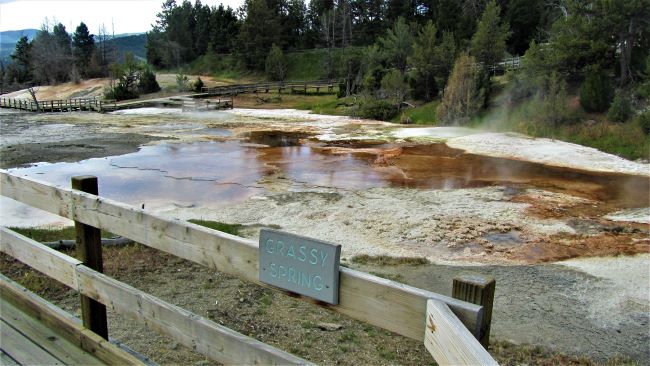
We started out from at the trailhead near the Upper Terrace’s parking lot. First stop was the Angel Terrace named after an early settler in the area, who reportedly claimed that the terrace looked like an angel with outspread wings. On our way, we pass Grassy Spring, and a few unnamed thermal areas punctuated by ghostly tree skeletons. Next is the Narrow Gauge Terrace, named for its white calcium carbonate narrow ridges and steep drop-offs. We passed by the bleak, white cliff-side of New Highland Terrace which, at this time, is inactive.
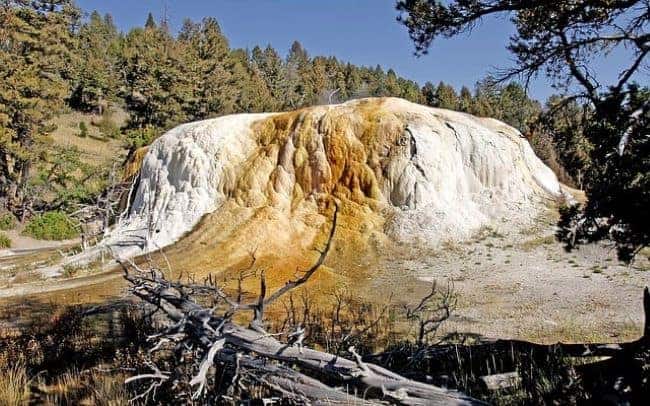
Prospect spring was active with hot water bubbling up and flowing across the surface. Continuing next is the Orange Spring Mound, named for its bright orange-green colors produced in multiple vents by thermophiles living in the hot water. As the boardwalk returns to the parking lot, we passed the dry bath lake, the sulfur pits and White Elephant Back Terrace. The fissure is named after its unique and complex shape, which resembles the back of a white elephant. The colors and patterns are the result of different temperatures, mineral concentrations, and bacterial activity in various parts of the terrace. Heading back to the parking lot, we encountered a male mule deer sprinting into the woods.

The Fort Yellowstone Historic District
The district is a collection of buildings and structures that were part of the original Fort Yellowstone military post established in 1891 to oversee the management and protection of the park. All the buildings you see with the red roofs are part of Fort Yellowstone. They built the fort when the U.S. Cavalry, Company M, managed the park for 32 years (1886-1918). Today, the district is listed on the National Register of Historic Places and is recognized for its architectural and historical significance.

The Albright Visitor Center
The Albright Visitor Center is named after Horace Albright, who was the second director of the National Park Service, and played a significant role in the development and expansion of Yellowstone National Park. The center features exhibit on the park’s geology, wildlife, and human history, as well as interactive displays and a bookstore. It is open year-round, but hours of operation may vary depending on the season. The building was originally constructed in 1909 as a U.S. Army hospital, but was later converted into a visitor center and museum in 1957.
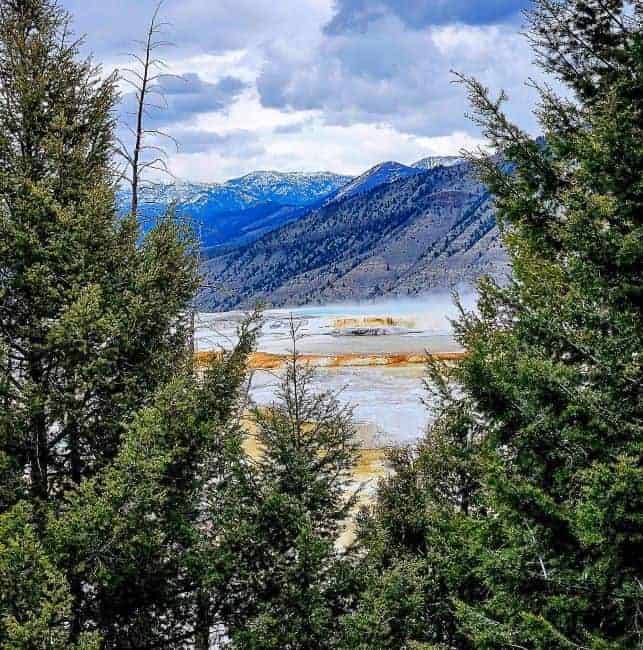
The visitor center is convenient to Mammoth lodging providing access to Wi-Fi. It is a hub for information on park services and activities, including guided tours, hiking trails, and ranger-led programs. There are informative animal exhibits on the first floor, which included well-done taxidermy mounts of wildlife found in the park. The Yellowstone Forever store has quality books and merchandise that can be purchased. Bathrooms are in the basement.

Old Fort Yellowstone: Whispers of History in the Heart of a National Treasure
The Fort Yellowstone post was established to protect and manage the park, which had been designated as the first national park in the United States in 1872.
After the establishment of the National Park Service in 1917, the role of the military in managing Yellowstone National Park gradually diminished. The fort was decommissioned in 1918 and many of the buildings were repurposed for use by the National Park Service. Today, the other buildings are part of the historic Fort Yellowstone that is offices and employee housing. Mammoth employees occupy most of the residence, so be respectful when viewing the buildings. Explore the beautiful complex either by a self-guided tour or an evening Ranger tour that is about an hour.
The entire complex at Mammoth, you see elk grazing. They are literally everywhere and can come out in the day or night. They love the eating the Kentucky Bluegrass the U.S. Cavalry planted when they managed the park. You’ll most likely see cow elk (females) until the rut season (mating season) when the bull elk (males) come into town with their shiny antlers. The rut season is September and October. There are also plenty of Unita ground squirrels in the green lawn areas.

Hiking Trails at Mammoth Hot Springs
Popular hiking trails in Mammoth include Beaver Ponds Trail, Bunsen Peak, Wraith Falls, Lava Creek, Blacktail Deer Creek to Yellowstone River Trail, Rescue Creek Trail, and Sepulcher Mountain. Don’t forget to carry bear spray and make lots of noise! You’re in bear country.
Beaver Ponds Loop Trail is an easy 5-mile loop trail with scenic views of the surrounding mountains and passes through several beaver ponds. It’s a great trail for wildlife viewing and birdwatching.
Note: Bears are highly active along this trail. Be bear aware, carry bear spray or travel in a group.
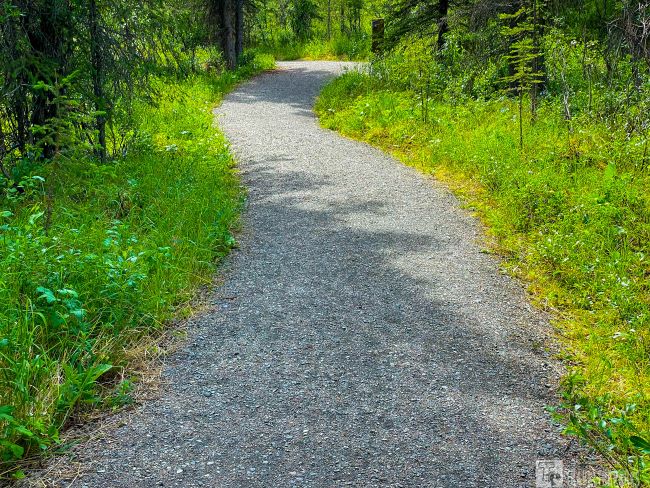
Best views from Bunson Peak
This is a moderate hike with an elevation gain of 1300 ft approximately 4.2 miles round trip. First called “observation peak” in 1872, they later renamed it to honor German chemist Dr. Robert Bunsen. It is advisable to have sturdy walking or hiking shoes as the trail is composed of rocky scree in some areas. A good trekking stick provides stability on the switchbacks. The mornings can be cool, so dressing in layers with a good Men’s and Women’s hooded fleece that can be removed as the temperatures warm.

The trail has many switchbacks as you trek the ridge with excellent 360-degree views. There is a cabin-weather station at the top of the mountain. I would suggest doing the trail in the morning and bring a picnic lunch to enjoy at the top of the peak. Take a lot of water and some snack food.. Be sure to have a refillable water bottle to quench your thirst.

Note: because of the raging floods of last summer, the boiling river is currently closed as it seems it may no longer exist
Soak in the Boiling River
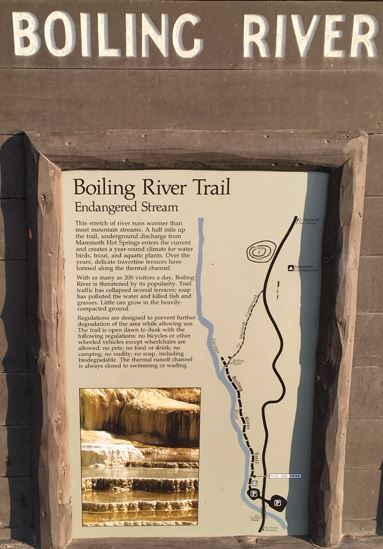
The boiling river is along the Gardiner River. The boiling river is a natural hot tub. This is naturally creating the hot spring when the waters from Mammoth Terraces enter the chilly waters of the Gardiner River. A short trail along the river’s edge gives access to the parking lot. There is one primitive bathroom in the parking area. They clearly mark the parking area. However, it is the only parking area between Mammoth and Gardiner.
Carry towels and wear your bathing suit if you plan to take a dip in the pool waters. I would recommend that you bring your water shoes with you, as the rocks can be slippery and difficult on your feet. The waters can invigorate, however, the current can be swift at different times of the year. This hot tub is popular with locales in the summer, so go early.
Just a mile farther on Hwy 89, you will cross the 45th parallel of latitude; there is a sign marking the line. The 45th parallel is an imaginary line that circles the globe halfway between the equator and the North Pole.
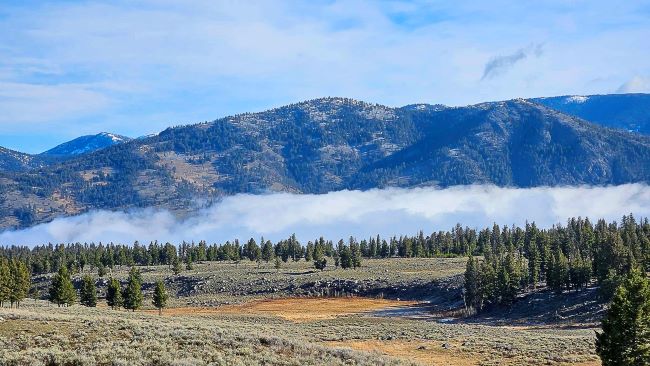
Walking Tour Gardiner, Montana
Gardiner, Montana, is only 5 miles, heading north on Hwy. 89. You follow the Gardiner River as you drive toward Gardiner. The river is good for fly-fishing. Gardiner is an excellent location to stock up on a few groceries and view the Roosevelt Arch. Johnson Gardiner, who was a fur trapper in the early 18th century, is how the river and town got their name. In the 1830s, he worked northwestern Yellowstone and sold his furs to the American Fur Company.

The Gardner River flows into the Yellowstone River. All 35 miles of the entire river are within Yellowstone National Park. It is a very quaint western town with a few shops and restaurants that can easily be walked in an hour. Gardiner Gifts is a large gift shop with a wonderful selection of souvenirs. The selection includes various candies, huckleberry products, clothing, ice cream, and other unique products.

In the basement section, we found metal art and chose a fish that would define this trip for us. Before walking to the Roosevelt arch, take the time to stop at the Yellowstone Forever. Yellowstone Forever is a nonprofit that supports Yellowstone National Park through educational programs & tours. All proceeds support park programs such as trail rehabilitation, youth programs, and wildlife preservation. One trip you can book is to take a wildlife tour with Flying Pig Raft company in Gardiner, MT. It is not cheap [$95/person], but it covers the road from Gardiner to the northeast of the park and back.

Walk through the Roosevelt Arch
Roosevelt Arch is the original entrance to Yellowstone, now the northwest entrance. The Arch is a massive stone structure, completed on August 15, 1903. They constructed it under the supervision of the U.S. Army at Fort Yellowstone began February 19, 1903. On April 24, 1903, President Theodore Roosevelt laid its official cornerstone. Theodore Roosevelt stated during his dedication speech that Yellowstone was “For the benefit and enjoyment of the people”. They inscribe it on the arch.

The towers are 52 feet high, 13 feet square at the base, approximately ½ that at the top, 25 feet apart. The side walls are approximately 40 feet. They built the entire structure of basaltic rock. The Arch permits vehicles just under 25 feet to pass through the center.
The Mammoth area has much to offer, consider staying multiple days. The mammoth hot springs stay open through the winter and is a good jumping-off point for snowmobiling and cross-country skiing. I think I would like to revisit this spot in the winter just for the solitude it brings!
Plan Ahead for Your Yellowstone Adventure
- Lodging Inside Yellowstone National Park: Accommodations within the park fill up quickly—reserve your stay up to a year in advance. Explore available lodging options on the official Yellowstone website to find the best fit for your trip.
- RV Rentals: Renting an RV is a fun and flexible way to experience Yellowstone. It gives you the freedom to explore at your own pace while keeping your accommodations with you.
- Camping in Yellowstone: If you’re planning to camp, check campground availability and details through the official National Park Service site.
- Maps & Travel Planning: Use the Yellowstone National Park map to get a sense of the park’s size, layout, and travel times between attractions. It’s an essential tool for efficient planning.
- Official Yellowstone National Park Website: Visit the NPS Yellowstone homepage for real-time updates on road conditions, closures, and general visitor information.
- Free Yellowstone Trip Planner: Download the free Yellowstone travel planner, available in digital format, for tips, itineraries, and essential info to help you make the most of your visit.
- Dining Options & Picnic Areas: Looking for a meal or a scenic place to eat? Yellowstone offers several dining facilities and 52 picnic areas throughout the park. Explore options on the park’s official dining page.
- Must-Have Travel Apps: Yellowstone GyPSy Guide App – A GPS-powered audio tour you can use offline. NPS Yellowstone App – Offers live updates on road conditions, geyser predictions, lodge/campground status, and more when you’re in areas with cell service. Both apps are available on the App Store and Google Play.
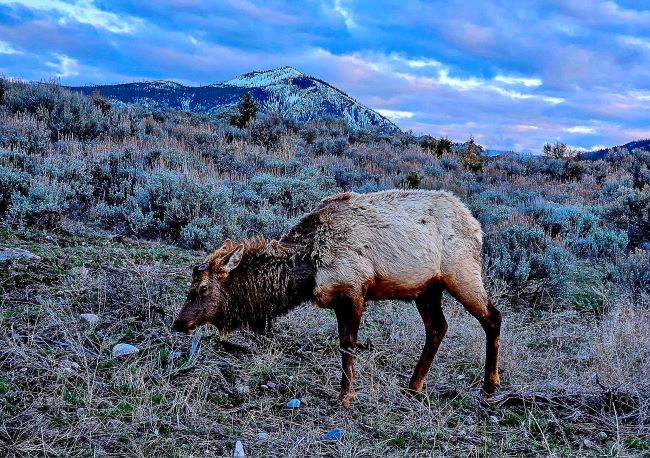
Final Thoughts on Visiting Vibrant Mammoth Hot Springs in Yellowstone National Park
One highlight of our visit to Mammoth Hot Springs was the opportunity to see the colorful and intricate geothermal formations that have been created by thousands of years of geologic activity. The hot springs and terraces are truly a wonder to behold and offer visitors a glimpse into the power and beauty of the natural world.
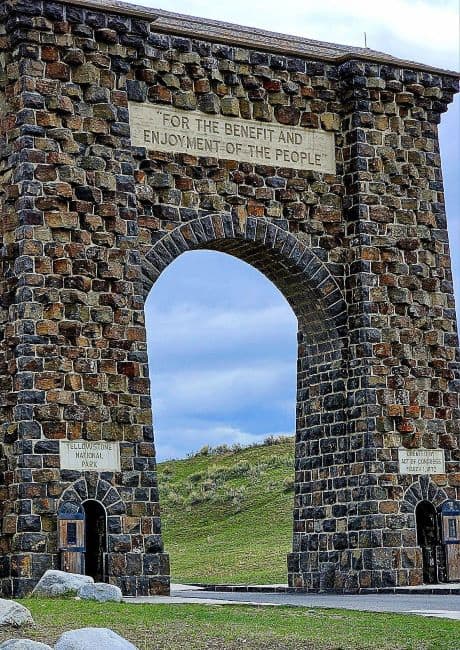
A visit to Mammoth Hot Springs is an adventure that is sure to be memorable and awe-inspiring. Whether you’re exploring the hiking trails, soaking in the hot springs, or simply enjoying the scenic beauty of the area, you’re sure to have an unforgettable experience.
What did you find the most interesting about Mammoth Hot Springs? Tell us in the comments below!




